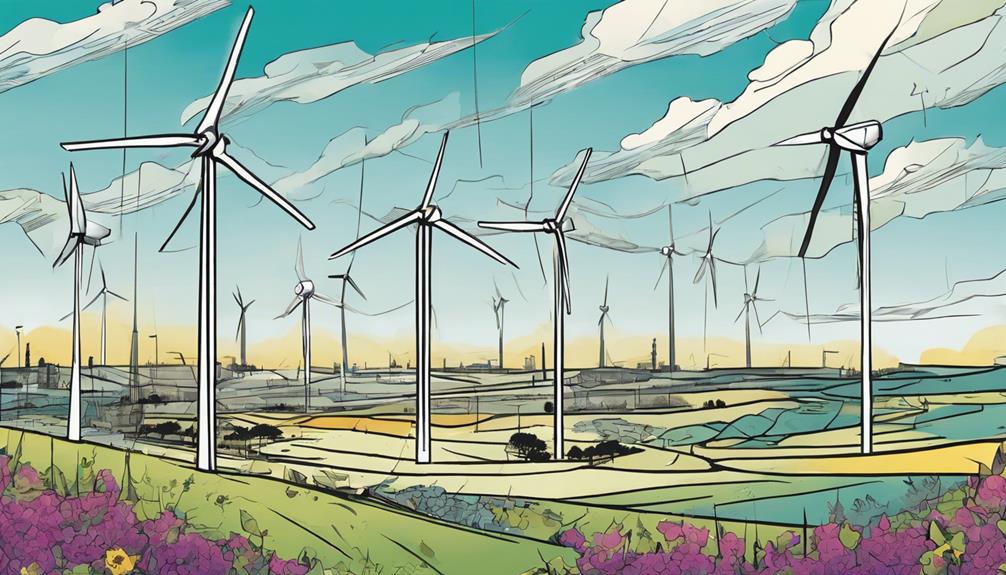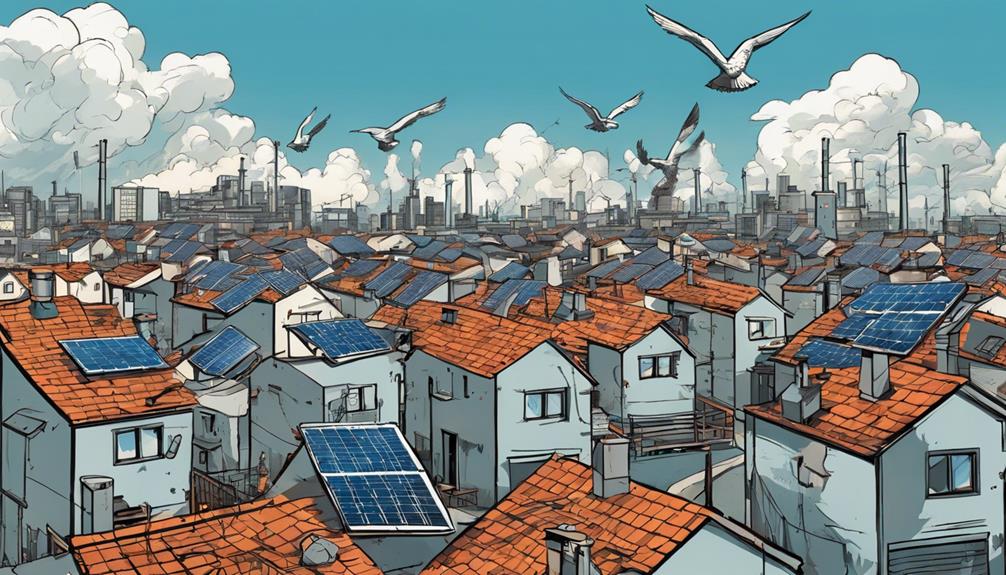Combine wind turbines and solar panels for maximum renewable energy output. This synergy secures consistent power while reducing environmental impact. Optimized placement secures round-the-clock energy production. Hybrid systems offer a cost-effective and sustainable solution. Ready to enhance your energy production and sustainability further?
Key Takeaways
- Hybrid systems ensure consistent power supply.
- Efficient placement optimizes energy production.
- Combining wind and solar enhances sustainability.
- Control systems maximize performance based on conditions.
- Integration of components boosts system flexibility.
Synergy of Wind and Solar
The synergy between wind and solar power creates a dynamic combination for maximizing renewable energy generation. When wind turbines and solar panels work together in hybrid systems, they form a sustainable energy solution that guarantees a consistent and diversified power supply. By combining the strengths of wind and solar energy, these systems enhance overall system resilience and efficiency.
Utilizing both renewable resources minimizes environmental impact and supports sustainability goals by reducing the carbon footprint associated with traditional energy sources. Wind turbines excel at filling energy gaps at night, providing uninterrupted power supply, while solar panels harness sunlight during the day to generate electricity. This strategic balance allows for round-the-clock energy production, ensuring a reliable and sustainable power system.
The integration of wind and solar power not only optimizes energy generation but also offers a cost-effective solution to cover power generation gaps and effectively manage power demands. By harnessing the strengths of both wind and solar technologies, hybrid systems represent a forward-thinking approach to sustainable energy production.
Efficiency and Sustainability

Maximizing effectiveness and sustainability, combined wind turbine and solar panel systems provide reliable renewable energy solutions. Wind-solar hybrid systems not only enhance the resilience of power generation but also reduce dependence on the grid, offering sustainable energy solutions.
By integrating wind and solar energy sources, these power generation systems help mitigate the impact of outages and price fluctuations, promoting Clean Energy practices. Moreover, these hybrid renewable energy systems play a vital role in reducing the carbon footprint and efficiently utilizing natural resources.
Efficient placement of solar panels and wind turbines is key to optimizing energy production while minimizing the environmental impact. Through the strategic balancing of power demands, wind turbine and solar panel combinations ensure energy independence and effectively cover power generation gaps.
Empowering Clean Energy Solutions

You can empower your community with clean and sustainable energy solutions by combining wind turbines and solar panels. This integration maximizes energy production efficiency and reliability, offering a balanced power generation profile for continuous energy supply.
Community Energy Empowerment
Embracing clean energy solutions through community energy empowerment empowers entire communities to take control of their energy destiny. By implementing wind-solar hybrid systems, communities can work towards a sustainable future while reducing their carbon footprint. This shared infrastructure not only promotes Green Energy but also helps in combating climate change by providing consistent and diversified energy production. Through community energy empowerment, residents can actively participate in shaping a cleaner and brighter future for generations to come.
| Benefits of Community Energy Empowerment |
|---|
| Promotes Sustainability |
| Reduces Carbon Footprint |
| Empowers Communities |
Sustainable Energy Revolution
Integrating wind turbines with solar panels marks a significant step in the sustainable energy revolution, empowering communities with innovative clean energy solutions. Wind solar hybrid systems offer a unique combination of solar and wind to generate consistent power, addressing intermittency issues prevalent in individual renewable sources.
By harnessing the excess energy produced by solar panels and wind turbines, these hybrid systems ensure a reliable power supply even when one source may not be as productive.
The integration of wind turbines with solar panels not only enhances the efficiency of power systems but also contributes to a more sustainable energy grid. Hybrid systems play an essential role in balancing power demands, reducing dependency on fossil fuels, and minimizing the environmental impact of energy generation.
Through this sustainable energy revolution, communities can achieve greater energy independence and pave the way for a cleaner, brighter future powered by renewable sources.
Benefits of Hybrid Systems

Maximizing energy production and reliability, hybrid systems that combine wind turbines and solar panels offer numerous advantages. By harnessing the power of renewable energy sources, these systems bridge power generation gaps effectively, ensuring a consistent energy supply.
The integration of wind turbines and solar panels enhances system resilience and efficiency, enabling ideal utilization of available resources. Hybrid power systems efficiently balance power demands, promoting energy independence and sustainability while reducing reliance on the traditional power grid.
Control systems within hybrid setups manage energy flow seamlessly, optimizing performance based on varying wind conditions and solar exposure. Additionally, energy storage solutions play a pivotal role in storing excess energy for later use, further enhancing system efficiency.
Setting Up Hybrid Systems

Selecting a compatible charge control unit is crucial when setting up a hybrid system that combines wind turbines and solar panels. The charge control unit plays a critical role in regulating the flow of electricity from both sources, ensuring efficient charging of batteries and preventing overcharging. Additionally, incorporating a diversion load for wind turbines can further enhance the safety and performance of the system by redirecting excess energy to prevent damage.
When setting up a hybrid system, optimizing the placement of wind turbines and solar panels is key to maximizing energy output. Consider factors such as sunlight exposure, wind patterns, and potential obstructions to guarantee the most effective placement. Furthermore, using hybrid charge controllers designed to handle inputs from both turbines and panels can streamline the energy generation process and improve overall system efficiency.
| Aspect | Importance | Considerations |
|---|---|---|
| Charge Control Unit | Critical | Compatibility, efficiency |
| Diversion Load | Enhances Safety | Overcharging prevention |
| Placement | Maximizing Output | Sunlight exposure, wind patterns, obstructions |
| Charge Controllers | Efficiency | Handling inputs from turbines and panels |
When setting up a wind-solar hybrid system, these elements are crucial for achieving optimal performance and harnessing renewable energy effectively.
Expanding Hybrid Systems

When expanding hybrid systems, incorporating additional components improves overall efficiency and flexibility. By integrating more wind turbines and solar panels, you can effectively balance power consumption and work towards achieving grid independence.
This expansion not only allows for optimized system output but also paves the way for future system growth. Allocating resources based on the output of each component, whether it be wind turbines or solar panels, guarantees the effectiveness of the hybrid setup.
Moreover, adding specialized components like a DC Water Heating Element for power dump can further enhance the overall efficiency of the system. Upgrading the charge controller as needed is essential for adapting to the expanding hybrid system, ensuring that it remains flexible and capable of handling increased capacity.
With these strategic additions and upgrades, you can maximize the renewable energy output of your hybrid system while moving towards greater sustainability and energy independence.
Considerations for Hybrid Systems

To optimize performance and efficiency in hybrid systems, careful considerations must be made regarding the integration of wind turbines and solar panels. Hybrid systems combining these renewable energy sources offer a reliable way to enhance energy production and achieve greater energy independence.
The strategic placement and zoning of wind turbines and solar panels are crucial for optimizing their performance. By harnessing the complementary nature of wind and solar power, hybrid systems can effectively cover power generation gaps, ensuring a continuous and diversified energy supply.
In managing the energy output from both wind turbines and solar panels, hybrid charge controllers and diversion loads play important roles. These components help regulate the flow of electricity, ensuring that the system operates efficiently and effectively. Properly configured charge controllers prevent overcharging of batteries, while diversion loads help dissipate excess energy to protect the system from damage.
Frequently Asked Questions
Can Solar Panels and Wind Turbines Work Together?
Yes, they can work together seamlessly. Solar panels and wind turbines in a hybrid system efficiently maximize renewable energy generation. Their combined efforts provide a balanced power generation profile, enhancing overall system efficiency for a sustainable energy solution.
Do Wind Turbines or Solar Panels Produce More Energy?
You know, wind turbines and solar panels each have their strengths. Wind turbines churn out more energy, like a powerful giant, while solar panels gleam brightly in the sun. Together, they make a dynamic renewable energy duo.
How Many Solar Panels Does It Take to Equal One Wind Turbine?
To match the energy output of a single wind turbine, you might need approximately 10 solar panels. Wind turbines are more efficient in generating energy compared to individual solar panels, making them ideal for large-scale renewable energy production.
What Is the Inherent Limitation to Both Solar and Wind as Renewable Energy Sources?
The inherent limitation to both solar and wind as renewable energy sources is their intermittency due to factors like nighttime, clouds, wind variability, and extreme temperatures, impacting continuous power supply. This variability challenges consistent output.
How Can Solar Panels be Combined with Wind Turbines to Maximize Renewable Energy Output?
Solar panels and wind turbines can be combined to maximize renewable energy output by harnessing sunlight for power during the day and utilizing wind energy during the night or when sunlight is limited. This combination enables a more consistent and reliable energy production, making the most of natural resources.
Conclusion
To sum up, combining wind turbines and solar panels is like having two superheroes working together to save the planet. By harnessing the power of both renewable energy sources, we can maximize efficiency and sustainability.
It's time to embrace hybrid systems and empower clean energy solutions for a brighter future. Let the wind and sun join forces to create a powerful renewable energy alliance.










